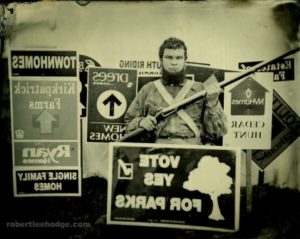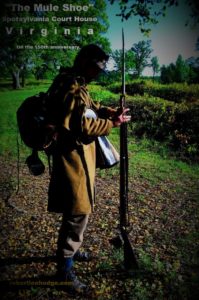Photo by Robert Szabo
My interest and concern for the protection of our Civil War battlefields began in June 1991 . . .
. . . when I visited a battlefield about 50 miles south of Washington DC oddly named “The Wilderness”. It doesn’t have quite the ring to the ear as places like a Gettysburg, or a Shiloh, or an Antietam have, but I had read about the battle some and had a curiosity about it. The combat began in a tangled undergrowth locals called the Wilderness in May of 1864 when Southern general Robert E. Lee’s gray-clad army of 66,000 Rebels attacked Yankee general Ulysses S. Grant’s 120,000 Federals. It was Clash of the Titans. Lee and Grant had never fought each other before. In two days 30,000 man and boys fell in another unimaginable bloodbath amongst the burning forests. Grant, instead of turning his stung northern army around and retreat to Washington (like all previous defeated Federal commanders in the past three years) he pushed on to grind Lee’s army down, and end the war 11-months later. It was at the Wilderness where the psychology of the war changed.
I had read about the Wilderness battle as a kid and wanted to get there someday to see the battlefield, and walk it. It was another way to connect to historic memory – going to the spot to see it, and to appreciate it more clearly. When I saw the Wilderness battlefield in 1991 I was floored that only about 20% of the battlefield had been protected, and subdivisions where being built in the center of it. That was my wake-up call in get involved in preservation. On that June day instead of hearing birds chirping and the wind blowing, I heard circular saws and hammers putting up the latest identikit homes, in many cases a few feet away from the dirt earthworks the soldiers dug in 1864. The juxtaposition of the homes to the earthworks was hard to stomach. I did not understand it. I had assumed the big battlefields had been protected by the government.
After that disturbing Wilderness trip I began to become aware to what was happening to not only the Virginia battlefields, but sizeable historic sites around America.
My interest in military history and social history made me into somewhat of an environmentalist. The interest in the protection of Civil War history, through saving the battlefields, opened my mind up to how fast America was losing family farms and hardwood forests. I have always thought of the protection of physical military history, like battlefield landscapes, as essential to help us further define why events transpired in the conflicts as they did. I guess what I am trying to explain is the functional justification as a reason to protect battlefields of major significance.
There is also the argument to save sites of major historic significance as having a spiritual-moral connection, akin to cemeteries. Many of these sites were massive killing fields and so there is reverence for some of those places. They are in some cases literally cemeteries without headstones.
To learn more about saving historic greenspace around The Wilderness and other battlefields nearby — Spotsylvania Court House, Chancellorsville, Fredericksburg, and Salem Church — please visit www.cvbt.org — The website of the Central Virginia Battlefields Trust. CVBT is a group I belong to that has saved over 1,100 acres in The Wilderness/Fredericksburg, Virginia area.




